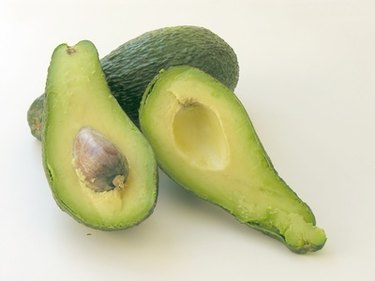
Avocado trees were first imported into Florida in 1833, according to the University of Florida Extension website, and are a commonly seen fruit tree in the state. Avocado trees bear a fruit that is a green, black or reddish berry, consisting of a large seed surrounded by a flavorful flesh that is high in oil content. Avocado varieties fall into three groups: "West Indian," "Guatemalan" and "Mexican." Many of these varieties thrive in Florida.
Pollock
Video of the Day
Pollock is a West Indian variety of avocado that comes to maturity from early July to mid-September. It bears an oblong to pear-shaped green fruit of superior quality that weighs 1 to 5 pounds. Pollock avocado trees grow 30 feet in height with a 20 foot spread. It has a low tolerance to cold, low production and is resistant to scab. According to Purdue University, Pollock originated in Miami before 1896, and was first commercially propagated fruit in the state in 1901.
Video of the Day
Russell
The Russell avocado produces a fruit that is pear-shaped at the base with a long neck, similar to that of a gourd. The fruit weighs 1 ½ to 2 ½ pounds, and has an excellent quality flesh. The Russell avocado originated in Islandmorada in the Florida Keys and is a West Indian variety of avocado. This variety of avocado matures in July and August. It has a low cold tolerance, moderate production and is resistant to scab. Growing 25 feet in height with a 15 foot spread, the Russell is a variety that is recommended for home gardens.
Reed
Patented in California in 1960, the Reed avocado was introduced to Florida due to its late season maturity, with hopes it would fill the gap in this area in commercial production. Maturing from mid-December through March, this Guatemalan variety of avocado produces a good quality fruit that weighs ½ to 1 pound. The fruit has a cream-colored flesh with a rich and slightly nutty flavor. It grows to a height of 30 feet, with a diameter of 20 feet, has moderate cold tolerance, high production and is resistant to scab. Reed is a variety that is often recommended for home planting.
Tonnage
Another Guatemalan variety of avocado, Tonnage was first planted in Florida in 1916, and was propagated commercially in 1930, according to the Purdue University website. It produces a pear-shaped avocado with a green flesh and a rich flavor. Weighing 1 to 1 ½ pounds, the fruit matures from mid-September to mid-October. Tonnage has a high tolerance to cold and is a moderate producer. It is mildly susceptible to scab. Tonnage grows to be 30 feet in height and 20 feet in diameter.
Booth 8
Booth 8 is a Guatemalan and West Indian hybrid variety of avocado. Growing to a height of 30 feet with a diameter of 20 feet, Booth 8 matures in late August through December. It has a moderate cold tolerance, is a high producer and has a mild susceptibility to scab. This variety of avocado is recommended for the home garden. It produces an oblong fruit that weighes 1 to 1 ½ pounds, of fair quality.